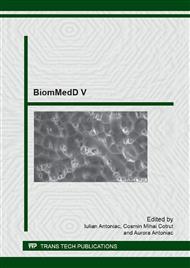p.87
p.91
p.95
p.101
p.107
p.115
p.119
p.125
p.129
Specific Biomaterials Used within the Department of Anatomy
Abstract:
As one of our main topics of interest within the Department of Anatomy, the usage of biomaterials involved two directions: preparation of anatomical casts by injection and corrosion and preservation of anatomical samples through plastination. For injection we used several substances, such as polyvinyl chloride, with the solvent cyclohexanone, a polyester oil used in furnishing and glass fiber industry and mostly TECHNOVIT 7143, of German production. Another preservation method that includes the usage of biopolymers is plastination, a perfect method for the preservation of perishable biological specimens, especially for soft, putrifiable ones with high water content. The method we applied is the silicone plastination (S10) that addresses to macroscopical samples, such as internal organs (hearts, kidneys) or slices of nervous tissue (brain slices) greater than 10 mm, samples resulted from the dissection process in the Anatomy Department.
Info:
Periodical:
Pages:
107-111
Citation:
Online since:
September 2013
Authors:
Keywords:
Price:
Сopyright:
© 2014 Trans Tech Publications Ltd. All Rights Reserved
Share:
Citation:


